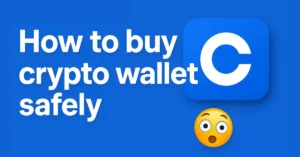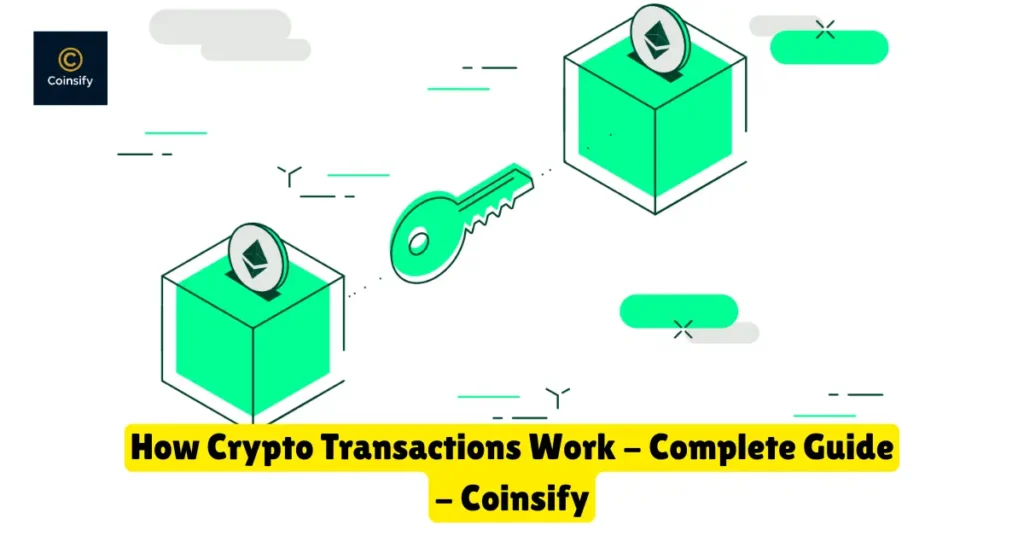How Crypto Transactions Work
Introduction
Cryptocurrency has quickly become one of the most talked-about innovations in the digital age. Whether you’re sending Bitcoin to a friend, paying for a service with Ethereum, or simply exploring the world of digital assets, crypto transactions are at the heart of it all. But have you ever wondered what happens when you hit “send” on a crypto wallet?
Unlike traditional banking, where transactions are handled by centralized institutions, cryptocurrency operates on decentralized networks using advanced cryptography and blockchain technology. This might sound complex, but the process can be broken down into simple, understandable steps. In this blog, we’ll walk you through what happens behind the scenes during a crypto transaction, so you can better understand how value moves securely in the world of digital finance.
Step-by-Step Breakdown of a Crypto Transaction
Understanding how a cryptocurrency transaction works might seem overwhelming at first, but it’s easier when broken into steps. Here’s what happens when someone sends crypto from one wallet to another:
Step 1: Initiating the Transaction
- The process begins when the sender opens their crypto wallet and enters the recipient’s public wallet address. They choose the amount to send and confirm the transaction. This action triggers the transaction process on the blockchain network.
Step 2: Creating a Digital Signature
- Once the transaction is created, it must be signed by the sender’s private key. This digital signature acts as proof that the transaction was authorized by the wallet owner and has not been altered. It’s a critical security step that ensures authenticity.
Step 3: Broadcasting to the Network
- After signing, the transaction is broadcast to the entire cryptocurrency network. This means it’s shared with multiple computers (called nodes) that keep the blockchain running. At this point, the transaction is waiting to be verified.
Step 4: Verification by Miners or Validators
Once the transaction reaches the network, it’s checked for accuracy. Miners (in proof-of-work systems like Bitcoin) or validators (in proof-of-stake systems like Ethereum 2.0) verify that:
- The sender has enough balance
- The digital signature is valid
- The transaction follows the network’s rules
- Only verified transactions can be added to the blockchain.
Step 5: Adding to a Block
- Once verified, the transaction is grouped with others into a block. This block is then added to the blockchain by a miner or validator. Each block is connected to the one before it, creating a secure chain of records.
Step 6: Confirmation and Completion
- After being added to the blockchain, the transaction is considered confirmed. The number of confirmations can vary depending on the cryptocurrency. With each new block added, the transaction becomes more secure. Once confirmed, the funds arrive in the recipient’s wallet, and the transaction is complete.
Behind the Scenes: Key Technologies Involved
To truly understand what powers a crypto transaction, it’s important to look at the core technologies working quietly in the background. These systems ensure that every transaction is secure, transparent, and decentralized.
Blockchain Technology
The blockchain is the backbone of every cryptocurrency. It’s a distributed digital ledger that records every transaction made across the network. Instead of relying on a central authority (like a bank), blockchain uses a network of computers (nodes) to maintain and validate the record.
Each new transaction is added to a block, and once the block is verified, it becomes a permanent part of the chain. This makes the data:
- Transparent (viewable by anyone)
- Immutable (cannot be changed)
- Trustless (no need to trust a middleman)
Crypto Wallets
A crypto wallet is a digital tool used to store, send, and receive cryptocurrencies. It doesn’t store the coins themselves, but rather the private and public keys needed to access and control your funds on the blockchain.
There are two main types of wallets:
- Hot Wallets: Connected to the internet (mobile or web wallets). Convenient but more exposed to online threats.
- Cold Wallets: Offline storage (hardware or paper wallets). More secure but less convenient for quick transactions.
Public and Private Keys
These cryptographic keys are essential for authorizing and receiving transactions:
- Public Key: Works like a bank account number. You can share it with others so they can send you cryptocurrency.
- Private Key: Works like a PIN or password. It should always be kept secret because it gives full control over your funds. It’s used to digitally sign transactions and prove ownership.
If someone has your private key, they can access and spend your crypto. That’s why wallet security is so important.
Miners and Validators
Depending on the type of blockchain, transactions are confirmed through either mining or validating:
- Miners (Proof-of-Work): Compete to solve complex puzzles to validate transactions and add new blocks (used in Bitcoin).
- Validators (Proof-of-Stake): Are selected to confirm transactions based on the amount of crypto they hold and are willing to “stake” (used in newer systems like Ethereum 2.0).
Both systems help prevent fraud, ensure consensus, and keep the blockchain running smoothly.
How Long Does a Transaction Take?
The time it takes to complete a crypto transaction depends on several factors, including the blockchain network being used, the current network traffic, and the transaction fee attached.
Blockchain Type Matters
Different cryptocurrencies operate on different blockchains, and each has its transaction speed:
- Bitcoin: Typically takes 10 minutes for one confirmation, but it can take up to an hour for full security (6 confirmations).
- Ethereum: Usually completes within a few minutes, though congestion can slow it down.
- Litecoin: Takes about 2.5 minutes per block.
- Solana / Polygon: Known for much faster speeds—often just seconds.
Network Congestion
If a blockchain network is overloaded with too many transactions at once, it can slow down significantly. This is especially common during market surges or when popular NFT or DeFi projects are active.
Transaction Fees (Gas Fees)
Higher fees can help your transaction get picked up faster by miners or validators. In networks like Ethereum, users often pay more during busy times to speed up confirmation. On some networks, paying too low a fee may cause your transaction to be delayed or even dropped.
Number of Confirmations Required
Some services or exchanges require multiple confirmations before they consider a transaction complete. For example, even if a transaction is added to a block, a platform may wait for 3 to 6 additional blocks to be added for security reasons.
Summary
A transaction can take anywhere from a few seconds to an hour, depending on:
- The cryptocurrency used
- Network congestion
- Fees paid
- Confirmation requirements
Planning and choosing the right network or timing can help ensure your transactions are processed quickly and reliably.
Are Crypto Transactions Reversible?
One of the most important things to understand about cryptocurrency transactions is this: they are irreversible.
Why Can’t They Be Reversed?
Unlike traditional banking systems, where you can request a chargeback or contact customer service to dispute a transaction, crypto operates on a decentralized blockchain. Once a transaction is confirmed and added to the blockchain, it becomes a permanent and unchangeable part of the ledger.
This is by design. Blockchain’s immutability (the inability to change data once it’s recorded) ensures security, transparency, and trustworthiness. But it also means that mistakes cannot be undone.
What If You Send Crypto to the Wrong Address?
If you accidentally send cryptocurrency to the wrong wallet address, there’s no built-in way to recover those funds. The only possible solution is to contact the recipient and hope they agree to send it back. If the address is inactive or unknown, the funds are effectively lost.
That’s why it’s critical to:
- Double-check the wallet address before sending
- Use copy-paste carefully to avoid typos
- Consider sending a small test amount first
Are There Any Exceptions?
Some centralized crypto exchanges may be able to reverse transactions within their system (like internal transfers between user accounts), but this does not apply to transactions on public blockchains.
Also, some blockchains are experimenting with smart contracts or account recovery systems, but these are limited and still evolving.
Frequently Asked Questions (FAQs)
What is a crypto transaction?
A crypto transaction is the process of sending digital currency (like Bitcoin or Ethereum) from one wallet to another using blockchain technology.
Do I need the internet to send or receive crypto?
Yes, you need an internet connection to access your wallet and broadcast the transaction to the blockchain network.
How long does a crypto transaction take?
It depends on the blockchain. Some transactions take a few seconds (like Solana), while others (like Bitcoin) may take 10 minutes or more. If the network is busy, it could take longer.
Can I cancel or reverse a crypto transaction?
No, once a crypto transaction is confirmed on the blockchain, it cannot be reversed. Always double-check the wallet address and amount before sending.
What happens if I send crypto to the wrong address?
If you send it to the wrong address, the funds are likely lost unless the owner of that address is willing to return them. There’s no way to force a refund.
What is a wallet address?
A wallet address is like your crypto account number. It’s a long string of letters and numbers that people use to send or receive cryptocurrency.
What are miners and validators?
Miners (in proof-of-work blockchains) and validators (in proof-of-stake blockchains) are people or computers that check and confirm crypto transactions to keep the network safe and accurate.
What is a confirmation in a crypto transaction?
A confirmation means your transaction has been verified and added to the blockchain. More confirmations make the transaction more secure.
Are crypto transactions safe?
Yes, they are very secure thanks to encryption and blockchain technology. But it’s your responsibility to protect your wallet and private key.
Can someone see my transaction?
Yes, most blockchain transactions are public and can be viewed by anyone. However, your name or personal identity is not shown—only your wallet address.
Conclusion
Crypto transactions may seem complex at first, but once you understand the steps, it all starts to make sense. The process is fast, secure, and transparent, from sending coins to confirming them on the blockchain. Just remember—always double-check the wallet address and keep your private key safe. With a little knowledge and caution, you can use cryptocurrency with confidence.
Also read
- What is a Crypto Wallet and How Does It Work? – Coinsify
- 10 Crypto Terms Every Beginner Must Know – Coinsify
- What is Blockchain Technology – Complete Guide – Coinsify
- How to Buy Crypto Safely in 2025 – Complete Guide – Coinsify
- Bitcoin vs Ethereum: Key Differences Explained – Complete Guide
- Ultimate Blockchain Glossary: Learn Blockchain Terms Easily
- How to Buy Bitcoin Safely (Complete Beginner’s Guide)
- Top 10 Crypto Wallets for Beginners (2025 Edition)
- What is Cryptocurrency? A Beginner-Friendly Guide (2025)






